Class 10 Geography Chapter 5 Notes - Minerals and Energy Resources
| Table of contents |

|
| Introduction |

|
| What is a Mineral? |

|
| Ferrous Minerals |

|
| Non-Ferrous Minerals |

|
| Rock Minerals |

|
| Conservation of Minerals |

|
| Energy Resources |

|
| Conservation of Energy Resources |

|
Introduction
Minerals are integral to our daily lives, forming the backbone of the modern world. Everything around us, from the simplest household items to complex machinery and towering structures, is made from metals and minerals extracted from the earth's crust.
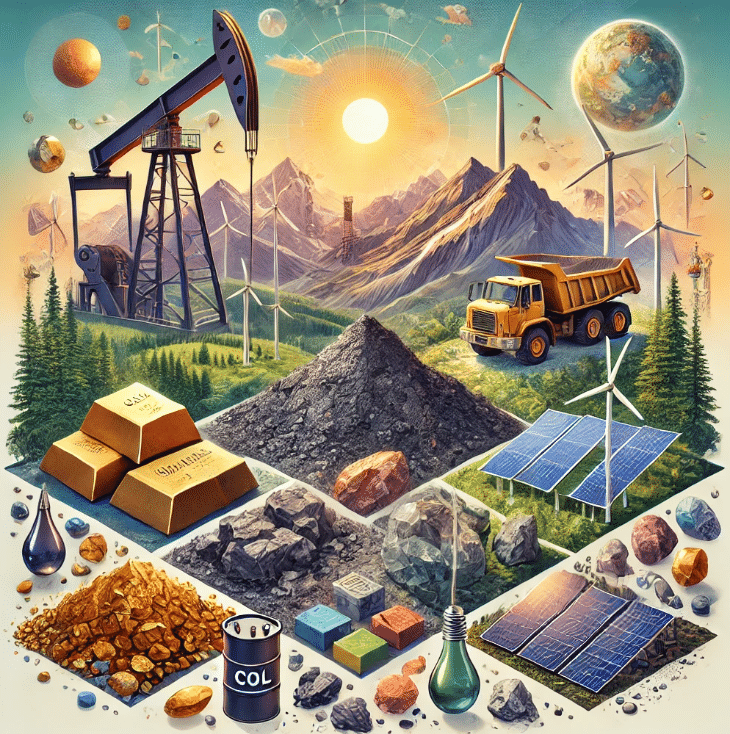 Minerals & Energy ResourcesThese essential resources are embedded in rocks and are refined to produce the metals we rely on.
Minerals & Energy ResourcesThese essential resources are embedded in rocks and are refined to produce the metals we rely on.
- Daily Use: From vehicles to roads and buildings, minerals are crucial in creating the infrastructure we use daily.
- Industrial Importance: Minerals are vital for manufacturing cars, buses, trains, airplanes, and the machinery that drives our industries.
- Energy Resources: Beyond their physical uses, minerals are also the source of the energy resources that power our world. They fuel our vehicles and generate electricity, making them indispensable in our daily lives.
Throughout history, minerals have been essential not only for industrial and construction purposes but also for cultural practices, including decoration, religious rituals, and ceremonial rites. This chapter explores the significance of minerals and energy resources in our lives, examining their types, distribution, and importance in shaping our modern world.
What is a Mineral?
Minerals are “homogeneous, naturally occurring substances with a definable internal structure.”
- They are formed through geological processes over millions of years.
- Rocks are combinations of homogenous substances called minerals.
- Minerals can be found in rocks, soil, and water.
- They serve various purposes, including providing nutrients for plants and animals, forming the building blocks of rocks, and being used in manufacturing various products like electronics, jewellery, and construction materials.
- Examples of minerals include quartz, feldspar, diamond, and calcite.
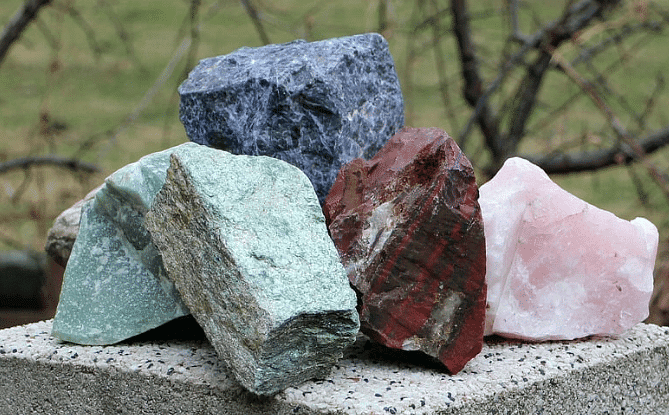 Minerals
Minerals
Mode of Occurrence of Minerals
Minerals are usually found in “ores”. The term ore is used to describe an accumulation of any mineral mixed with other elements.
Where are these minerals found?
- For an ore to be commercially viable, the mineral content must be in sufficient concentration to justify extraction.
- The type of geological formation in which ores are found affects how easily they can be mined.
- The formation also influences the cost of extraction, with some structures being more expensive to mine than others.
Let's Revise: What is a mineral? Give few examples of Mineral.
 View Answer
View Answer 
Ans: A mineral is a homogeneous, naturally occurring substance with a definable internal structure formed through geological processes. Examples of Minerals are quartz, feldspar, diamond, and calcite.
Types of Mineral Formations
1. In Igneous and Metamorphic Rocks:
- Minerals can crystallize from magma (molten rock) as it cools and solidifies underground or on the Earth's surface.
- Minerals can occur in cracks, crevices, faults, or joints.
- Veins: Smaller occurrences.
- Lodes: Larger occurrences.
- Formation: Minerals in liquid/molten and gaseous forms are forced upward, cooling and solidifying as they rise.
- Example: Tin, copper, zinc, and lead are obtained from veins and lodes.

2. In Sedimentary Rocks:
- Minerals can be deposited from water, often in layers, and form sedimentary rocks.
- They can precipitate from solution (e.g., salt deposits), accumulate from the remains of plants and animals (e.g., coal), or be transported and deposited by water, wind, or ice (e.g., sandstone, shale).
- Formation: Often under long periods of great heat and pressure.
- Example: Coal, iron ore, gypsum, potash salt, and sodium salt.
- Special Formation: Evaporation in arid regions leads to certain sedimentary minerals.

Let's Revise: How do minerals in igneous and metamorphic rocks differ in formation from those in sedimentary rocks?
 View Answer
View Answer 
Ans: Minerals in igneous and metamorphic rocks form from cooling magma or high-pressure changes, while sedimentary rock minerals form from water deposition or heat and pressure over time.
3. Decomposition of Surface Rocks:
- Some ores are formed through the decomposition of surface rocks.
- As surface rocks break down, soluble elements are removed, leaving behind a residual mass of weathered material.
- Bauxite, an important ore for aluminum, is formed through this process of residual formation.
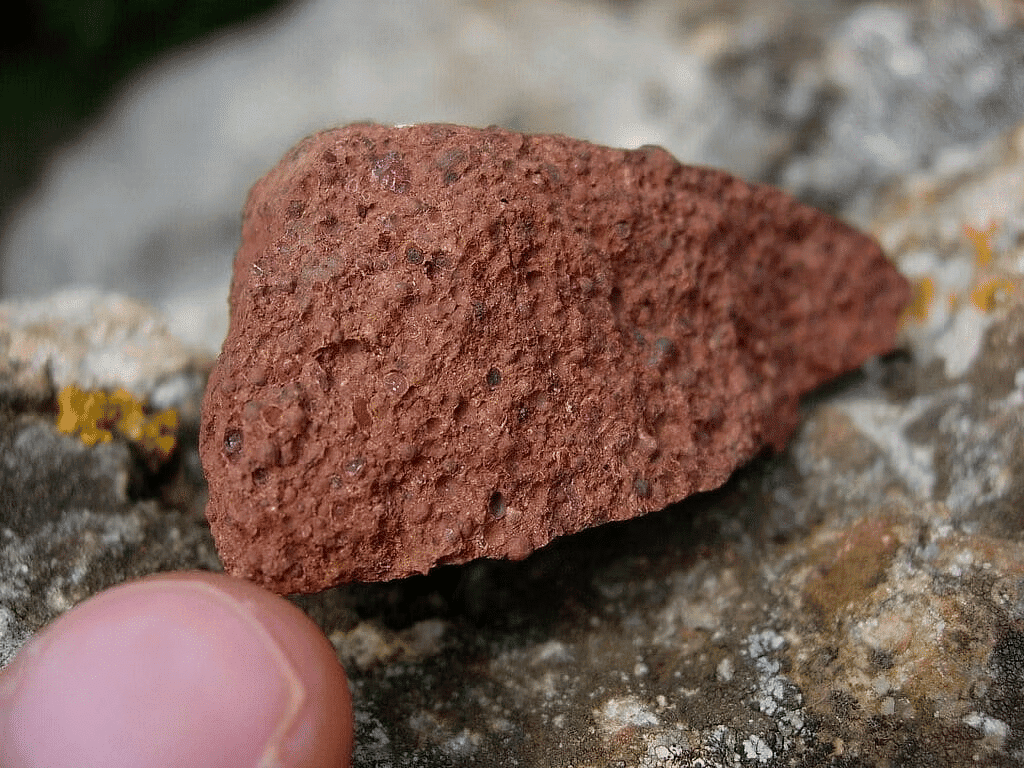 Bauxite
Bauxite
4. Alluvial Deposits (Placer Deposits):
- Certain minerals may occur as alluvial deposits in sands of valley floors and the base of hills.
- Typically contains minerals not corroded by water.
- Example: Gold, silver, tin, and platinum.

5. Ocean Waters and Beds:
- Ocean waters contain vast quantities of minerals, though many are too diffused for economic extraction.
- Common salt, magnesium, and bromine are derived from ocean waters.
- Manganese nodules are found in ocean beds.
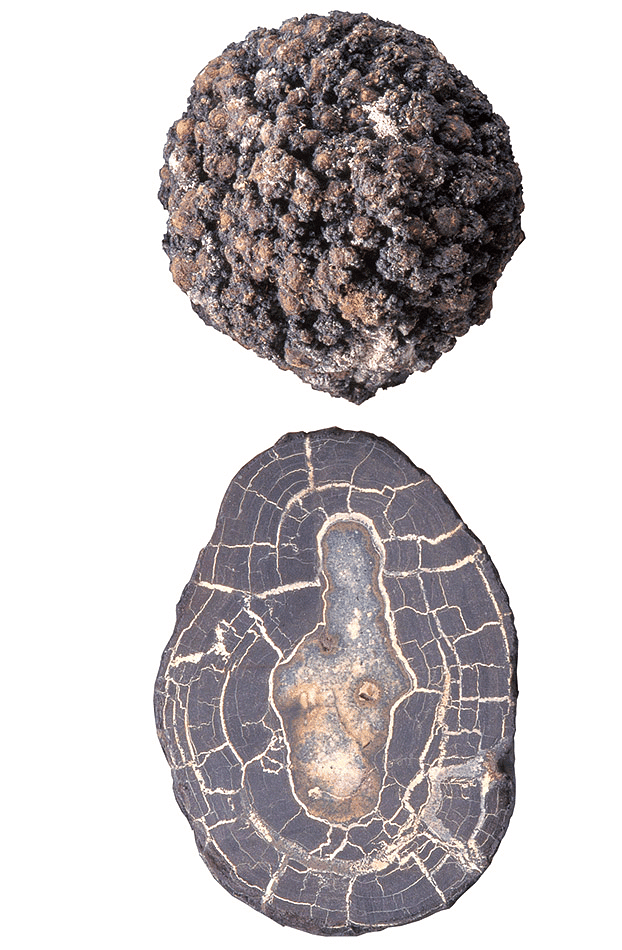 Manganese Nodules
Manganese Nodules
Let's Revise
Q: How is bauxite formed?
 View Answer
View Answer 
Ans: Bauxite is formed through the decomposition of surface rocks, leaving behind a residual mass of weathered material.
Q: What are placer deposits, and what types of minerals are typically found in them?
 View Answer
View Answer 
Ans: Placer deposits are alluvial deposits in valley sands or hill bases, containing durable minerals like gold, silver, tin, and platinum.
Distribution of Mineral Resources in India:
- Peninsular Rocks: Contain most reserves of coal, metallic minerals, mica, and many other non-metallic minerals.
- Sedimentary Rocks: Found on the western and eastern flanks of the peninsula, particularly in Gujarat and Assam, containing most of the petroleum deposits.
- Rajasthan: With rock systems of the peninsula, has reserves of many non-ferrous minerals.
- Alluvial Plains of North India: Almost devoid of economic minerals.
The distribution of minerals in India is uneven due to differences in geological structures, processes, and time involved in the formation of minerals.
Ferrous Minerals
Ferrous minerals are minerals that contain iron.
- They are an essential raw material for the iron and steel industry, which is one of the key industries driving industrial development worldwide.
- Ferrous minerals constitute about three-fourths of the total value of metallic mineral production.
- They provide a robust foundation for the development of metallurgical industries.
- India not only meets its internal demands but also exports significant quantities of ferrous minerals.
Some common ferrous minerals include:
Iron Ore
Iron ore is the primary source of iron.
- It is found in various forms, such as magnetite and hematite, and typically contains high levels of iron, ranging from 50% to 70% or more.
- Iron ore is a fundamental mineral and the backbone of industrial development.
- India possesses abundant resources of high-quality iron ores.
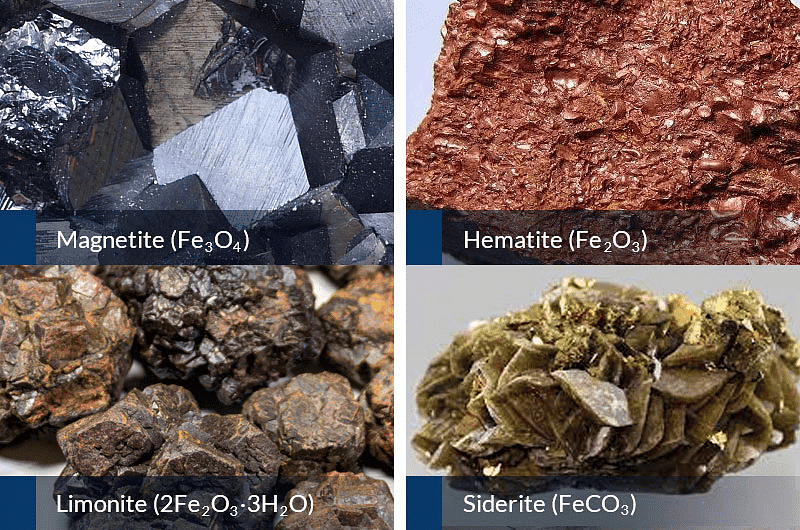 Iron Ore
Iron Ore
Magnetite: The finest iron ore with up to 70% iron content and excellent magnetic qualities, especially valuable in the electrical industry.
Hematite: The most significant industrial iron ore in terms of usage, with 50-60% iron content.
Production (2018-19): Odisha, Chhattisgarh, Karnataka, and Jharkhand accounted for 97% of iron ore production. The remaining 3% was produced by other states.
Major Iron Ore Belts in India:
1. Odisha-Jharkhand belt:
- High-grade hematite ore found in Badampahar mines in Mayurbhanj and Kendujhar districts of Odisha.
- Gua and Noamundi (Singbhum district, Jharkhand) are known for hematite iron ore mining.
2. Durg-Bastar-Chandrapur belt:
- Very high-grade hematites found in the Bailadila range of hills in Bastar district, Chhattisgarh.
- Iron ore from these mines is exported to Japan and South Korea via Vishakhapatnam port.
3. Ballari-Chitradurga-Chikkamagaluru-Tumakuru belt in Karnataka:
- Large reserves, Kudremukh deposits are known to be one of the world's largest.
- Kudremukh mines (Western Ghats, Karnataka) is a 100% export unit, known for one of the largest ore deposits globally.
- The ore is transported as slurry through a pipeline to a port near Mangaluru.
4. Maharashtra-Goa belt:
- Includes Goa and Ratnagiri district of Maharashtra.
- Though the ore quality is moderate, it is efficiently exploited, and iron ore is exported through Marmagao port.
ii. Manganese:
- Manganese is often considered a ferrous mineral because it is frequently found alongside iron ores.
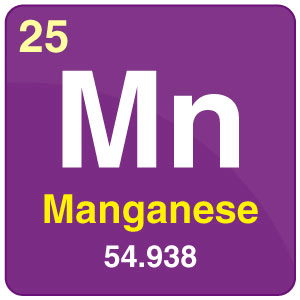
- While manganese itself is not ferrous, its presence in iron ore deposits is significant.
- Approximately 10 kg of manganese is required to produce one tonne of steel.
Uses:
1. Manufacturing steel and ferromanganese alloys.
2. Making bleaching powder, insecticides, and paints.
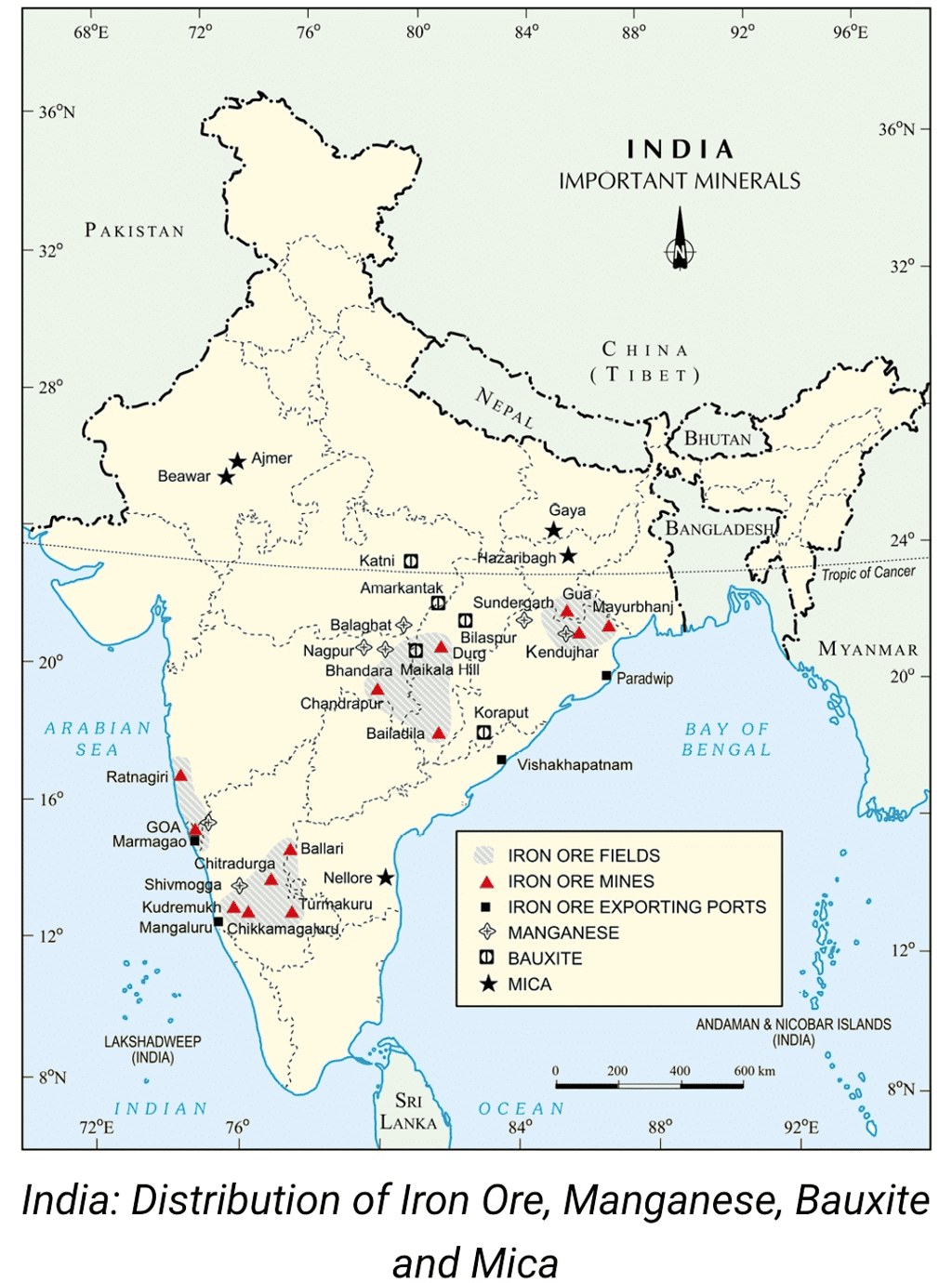
Non-Ferrous Minerals
- India’s reserves and production of non-ferrous minerals is not very satisfactory.
- Non-ferrous minerals do not contain iron as a primary constituent.
- These minerals are important for various industrial applications and are often used in alloys, electronics, and other specialized industries.
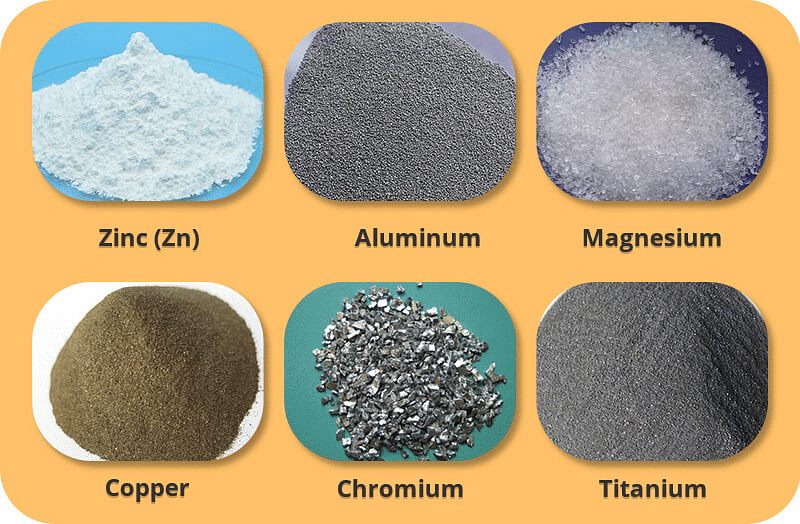
Here are two examples of non-ferrous minerals:
Copper
- Copper is a versatile metal known for its excellent conductivity, corrosion resistance, and malleability.
- It is widely used in electrical wiring, plumbing, roofing, and industrial machinery.
- Copper alloys, such as brass and bronze, are also valuable materials in various applications.
- Distribution: Found in Balaghat mines in Madhya Pradesh, Khetri mines in Rajasthan, and Singhbhum district of Jharkhand.
Bauxite
- Aluminium Extraction: Although several ores contain aluminium, bauxite—a clay-like substance—is the primary source from which alumina and subsequently aluminium is obtained.
- Formation of Bauxite Deposits: These deposits are formed by the decomposition of various rocks that are rich in aluminium silicates.
- Combines the strength of metals like iron with extreme lightness.
- Exhibits good conductivity and great malleability.
- Due to these properties, aluminium is a highly significant metal in various industries.
- Bauxite Deposits in India: Major deposits are found in the Amarkantak plateau, Maikal hills, and the Bilaspur-Katni plateau region.
- In 2016-17, Odisha was the largest bauxite-producing state in India, with the Panchpatmali deposits in Koraput district being the most significant.
- Major bauxite-producing countries include Australia, Guinea, Brazil, and China.
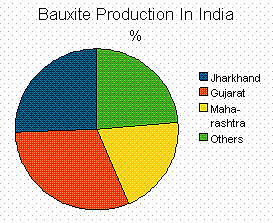
Let's Revise
Q: What are non-ferrous minerals?
 View Answer
View Answer 
Ans: Non-ferrous minerals do not contain iron and are used in industries for making alloys, electronics, and other specialized applications.
Q: Name two important copper mining areas in India.
 View Answer
View Answer 
Ans: Balaghat in Madhya Pradesh and Khetri in Rajasthan are major copper mining areas in India.
Non-Metallic Minerals
Non-metallic minerals are minerals that do not contain metals as their primary constituents. These minerals have diverse applications in industry, construction, agriculture, and other sectors. Here are some examples of non-metallic minerals:
Mica
Mica is a mineral made up of thin, sheet-like structures. It is valued for its electrical insulation properties, heat resistance, transparency, and flexibility. Mica is used in electrical and electronic industries for insulating components, in the production of paints, cosmetics, and plastics, and as a filler material in construction materials like cement and asphalt.
Mica deposits are found primarily in the Chota Nagpur plateau (Koderma-Gaya-Hazaribagh belt in Jharkhand), around Ajmer in Rajasthan, and in the Nellore mica belt of Andhra Pradesh.
Rock Minerals
Limestone
Limestone is a sedimentary rock composed mainly of calcium carbonate. It is one of the most abundant non-metallic minerals and is widely used in various industries. Limestone is a key raw material for the production of cement, as it provides the necessary calcium component. It is also used in the construction industry for building materials like aggregate, dimension stone, and as a flux in steelmaking.
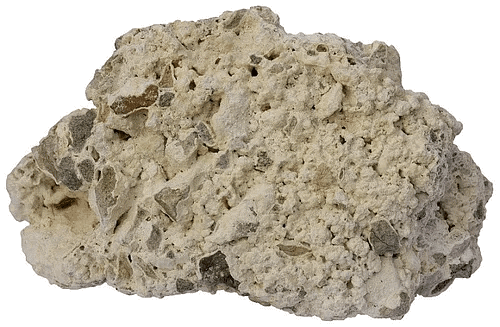 Limestone
Limestone
These non-metallic minerals contribute significantly to the global economy and are essential for the production of a wide range of goods and materials.
Hazards of Mining
Minning
- The dust and noxious fumes inhaled by miners make them vulnerable to pulmonary diseases.
- The risk of collapsing mine roofs, inundation, and fires in coalmines are a constant threat to miners.
- The water sources in the region get contaminated due to mining.
- Dumping of waste and slurry leads to degradation of land, and soil, and increases in stream and river pollution.
Conservation of Minerals
The total volume of workable mineral deposits is an insignificant fraction i.e. one per cent of the earth’s crust. We are rapidly consuming mineral resources that require millions of years to be created and concentrated.
- The geological processes of mineral formation are so slow that the rates of replenishment are infinitely small in comparison to the present rates of consumption.
- Mineral resources are, therefore, finite and non-renewable. Rich mineral deposits are our country's extremely valuable but short-lived possessions.
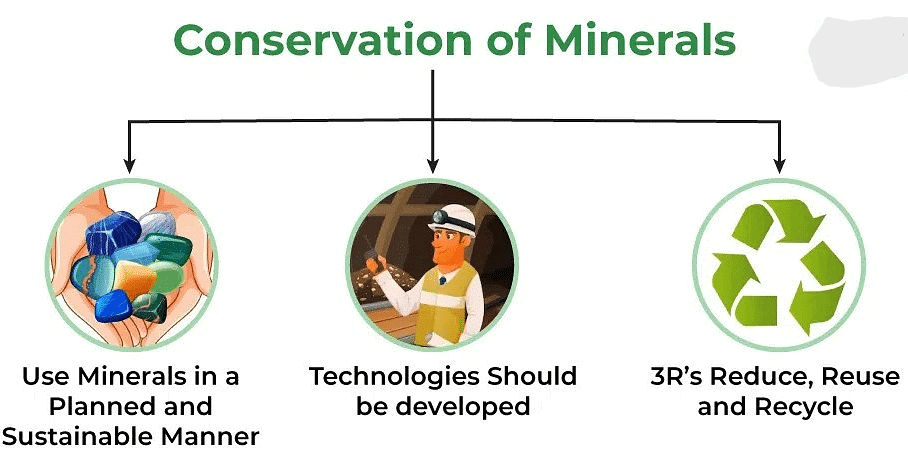
- Continued extraction of ores leads to increasing costs as mineral extraction comes from greater depths along with a decrease in quality.
- A conscious effort needs to be made to use our mineral resources in a planned and sustainable manner.
- Improved technologies need to be constantly evolved to allow the use of low-grade ores at low costs. Recycling metals, and using scrap metals and other substitutes are steps in conserving our mineral resources for the future.
Energy Resources
Energy resources are substances or systems that can be harnessed to produce energy in various forms, such as heat, electricity, or mechanical work. These resources are essential for powering human activities, industries, transportation, and infrastructure.
Energy resources can be classified as:
- Conventional Sources: These include firewood, cattle dung cake, coal, petroleum, natural gas and electricity.
- Non-conventional Sources: These includes solar, wind, tidal, geothermal, biogas and atomic energy
1. Conventional Sources of Energy
Coal:
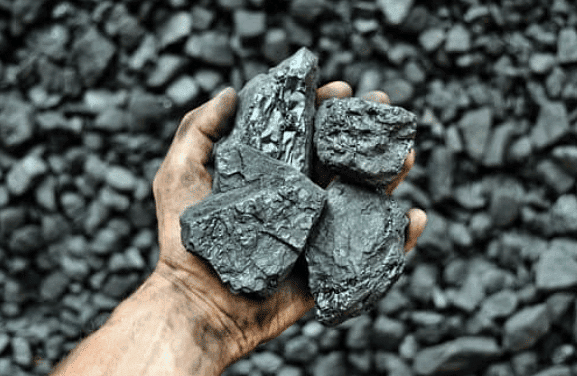 CoalCoal, the most abundant fossil fuel, serves various purposes including power generation, industrial energy supply, and domestic usage.
CoalCoal, the most abundant fossil fuel, serves various purposes including power generation, industrial energy supply, and domestic usage.
- Lignite, characterized by its softness and high moisture content, represents a lower-grade brown coal.
- Bituminous coal, formed under high temperature and pressure, constitutes a higher-grade variant.
- Anthracite, the highest quality hard coal, is prized for its purity.
- Key coalfields in India include Jharia, Raniganj, and Bokaro.
- The major resources of Gondwana coal, which are metallurgical coal, are located in Damodar valley (West Bengal-Jharkhand).
- Tertiary coals occur in the north eastern states of Meghalaya, Assam, Arunachal Pradesh, and Nagaland.
Petroleum: Petroleum
Petroleum
- Petroleum, a versatile resource, fuels heating and lighting, provides lubricants for machinery, and serves as raw material for multiple manufacturing sectors.
- Most petroleum deposits in India are found in anticlines and fault traps within rock formations from the tertiary age. Oil is typically trapped in the crests of upfolds (anticlines or domes) and is found in porous limestone or sandstone layers.
- Petroleum refineries play a central role, supporting synthetic textile, fertilizer, and various chemical industries.
- Major petroleum production areas in India encompass Mumbai High, Gujarat, and Assam.
Natural Gas:
- Natural Gas is found with petroleum deposits and is released when crude oil surfaces.
- Used as fuel for electricity generation, industrial heating, and as a raw material in chemical, petrochemical, and fertilizer industries.
- Emerging as a preferred transport fuel (CNG) and cooking fuel (PNG).
- Major reserves in India are in Mumbai High and Krishna-Godavari basin.
- The Hazira-Vijaipur-Jagdishpur (HVJ) gas pipeline, built by GAIL, was the first major gas infrastructure, linking Mumbai High with key industrial areas.
- India's gas infrastructure has expanded to 18,500 km and is expected to reach 34,000 km, forming a nationwide Gas Grid.
Let's Revise
Q: What are the three main types of coal, and how do they differ in quality?
 View Answer
View Answer 
Ans: Lignite is low-grade with high moisture, bituminous is higher-grade formed under pressure, and anthracite is the purest, hardest form of coal.
Q: Which are the major petroleum-producing areas in India?
 View Answer
View Answer 
Ans: Mumbai High, Gujarat, and Assam are the major petroleum-producing areas in India.
Electricity:
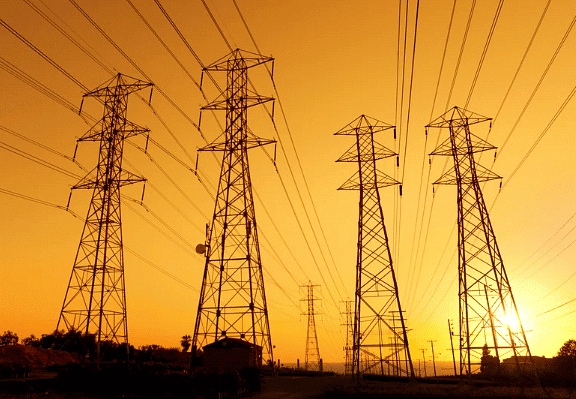
- Electricity generation primarily occurs through two methods:
- Hydroelectricity, derived from water-driven hydro turbines, stands as a renewable energy source, with India boasting numerous multipurpose projects like Bhakra Nangal and Damodar Valley Corporation.
- Thermal Power, generated by burning coal, petroleum, and natural gas to power turbines, relies on non-renewable fossil fuels.
2. Non-conventional Sources of Energy

i. Nuclear or Atomic Energy: Nuclear Energy is acquired by modifying the structure of atoms, with Uranium and Thorium serving as key elements for generating atomic or nuclear power.
ii. Solar Energy: Solar energy is harnessed from the Sun's light, and photovoltaic technology directly converts sunlight into electricity.
 Solar Energy
Solar Energy
iii. Wind Power: Wind Energy, or Wind Power, involves utilizing the force of wind to generate electricity, commonly achieved through the use of wind turbines. Tamil Nadu hosts the largest cluster of wind farms, spanning from Nagercoil to Madurai.
iv. Biogas: Biogas, a form of biofuel, naturally results from the decomposition of organic waste. It is notably efficient when produced from cattle dung and enhances the quality of manure. Gobar gas plants (using cattle dung) offer dual benefits: energy production and improved manure quality, reducing deforestation and dung cake burning.
v. Tidal Energy: Tidal energy, a hydropower form, transforms the energy derived from tides into usable power, primarily electricity. Ideal conditions for utilizing tidal energy are found in the Gulf of Khambhat, the Gulf of Kachchh in Gujarat on the western coast, and the Gangetic Delta in the Sunderban regions of West Bengal in India.
vi. Geo-Thermal Energy: Geothermal energy is the heat and electricity generated from the Earth's internal heat. The Earth's temperature increases with depth, creating high geothermal gradients in certain areas. In these areas, groundwater absorbs heat from rocks and becomes extremely hot. The heated groundwater rises to the surface as steam, which can be used to drive turbines and produce electricity. India has several hundred hot springs that could be utilized for generating electricity through geothermal energy. Two experimental geothermal energy projects in India: Parvati Valley near Manikaran, Himachal Pradesh and Puga Valley, Ladakh.
Let's Revise: What are Gobar gas plants, and what are their two main benefits?
 View Answer
View Answer 
Ans: Gobar gas plants use cattle dung to produce biogas, providing energy and improving manure quality, thus reducing deforestation.
- Energy is crucial for all sectors of the economy, including agriculture, industry, transport, and domestic use.
- The rising demand for energy has been driven by economic development since Independence.
- The increasing energy consumption highlights the urgent need for a sustainable energy development path, focusing on energy conservation and renewable energy sources.
- India's Energy Efficiency: India is currently among the least energy-efficient countries. A cautious and judicious use of limited energy resources is essential.
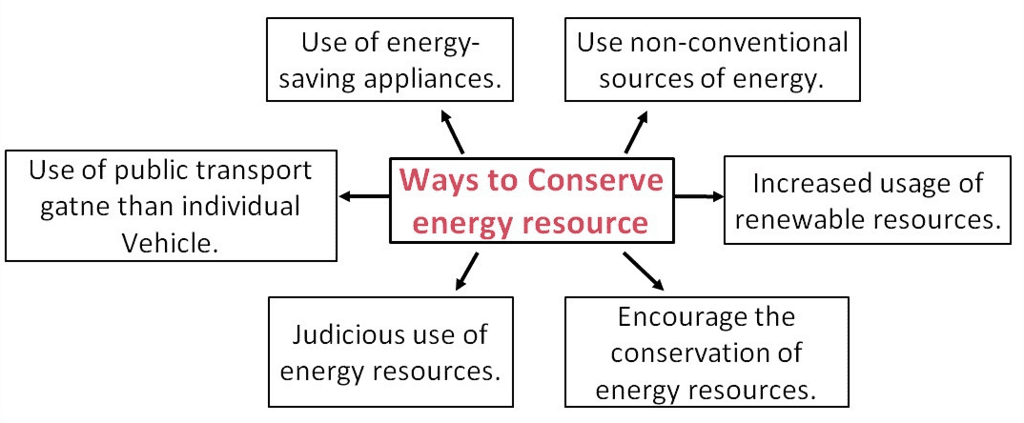
Here are some key strategies for conserving energy resources:
- Using public transport systems instead of individual vehicles
- Switching off electricity when not in use
- Using power-saving devices.
- Using non-conventional sources of energy
|
95 videos|815 docs|79 tests
|
FAQs on Class 10 Geography Chapter 5 Notes - Minerals and Energy Resources
| 1. What are the main types of minerals and their classifications? |  |
| 2. Why is the conservation of minerals important? |  |
| 3. What are energy resources, and how are they classified? |  |
| 4. How can we conserve energy resources in our daily lives? |  |
| 5. What role do minerals play in our economy and daily life? |  |
















